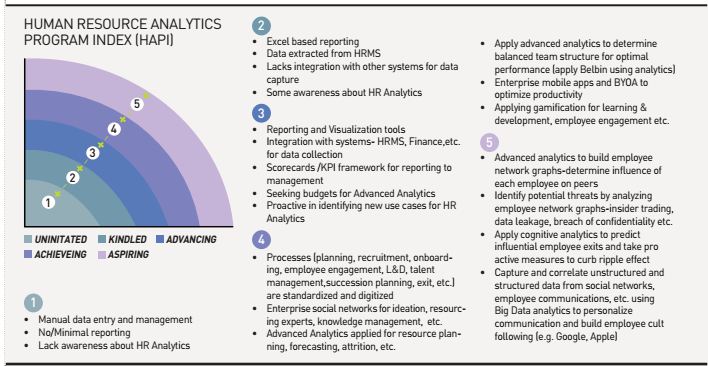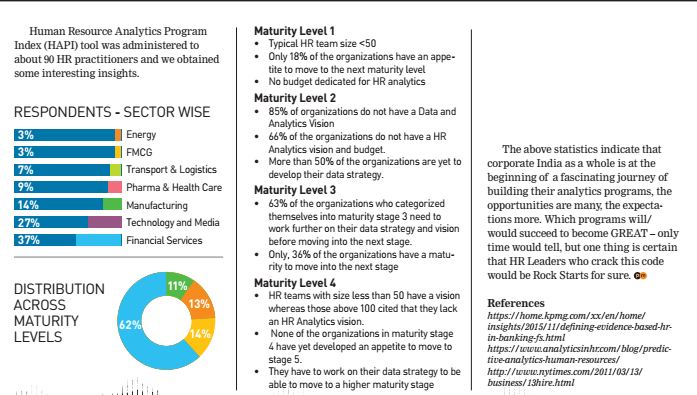Are You HAPI?

People are our biggest asset’ and ‘Talent is in short supply’ are the two statements that business leaders regularly share with leads to an interesting ask: If the people assets you have already can be compounded at a faster rate, wouldn’t it solve the latter issue? Further, how can HR leaders leverage ‘evidence based’ HR practices (aka analytics) to build a GREAT Program which provides unique insights and unbiased data, with shorter feedback loops. This would enable the Human Capital to grow at a faster pace. If this promise of faster Human Capital growth is fulfilled, HR leaders would become Rock Stars in the board room.

In my view, for a GREAT Analytics Program, we need to address the following five dimensions; else programs of this nature will never deliver their stated promise. The first is gumption. The U.S. Special Forces discovered that they could predict upfront (to a high degree of accuracy) as to which candidates would successfully complete their highly selective training program (potentially saving tons of money and also completely relooking at the evaluation process) basis only two factors that can be predetermined, one of which was whether the individual before being recruited could perform 80 pushups. IQ was ‘not’ a factor which was found relevant.
Now for insights like these to be brought into main stream organization, decision making requires Gumption and Sponsorship without which organization will do ‘Vanity’ projects that provide little more than bragging rights.
The second dimension of a successful program is resilience. Large organizational culture is all about standardization and optimization — they see innovative, break though practices like antibodies and quickly respond to stomp it to oblivion. Initiatives of this nature, after sponsorship, need to be thrown at the edge of the organization working in stealth mode without much fanfare and only after you have been able to build real world value do you move these teams back into the main stream. Then you hope, pray and push to make sure they get adopted.
The third dimension of a GREAT program is expertise. These solutions are not readily available; the magic portions have not been yet created. Organizations that are making progress are rolling up their sleeves and jumping the DIY (Do It Yourself) band wagon. You still need to be working with technology vendors, and advisors perhaps peers and consultants but a partner or a product is no longer at the center of a program. You are the center; the others are just supporting acts. This has a gestation period and that price has to be paid.
The fourth dimension of a GREAT program is agility. Like someone said, you should assume you will fail 9 times before it works. Hence, can you fail quickly and less expensively and continue to iterate and move forward. If they lead you to an Evidence Based HR program with clear goals and outcomes and ROI, and a 2-year implementation roadmap act super busy and quietly pass the opportunity. While goals are important, these programs require a leap of faith, capacity to deal with high degree of ambiguity, an ability to sniff out opportunities and constantly reassess goals and outcomes.
The last dimension is teamwork. Successful programs will require working with people one has never worked before, small startups that big organizations with their advanced vendor onboarding program discourage, or peers and competitors in a co-opted program that requires sharing of information, or vendors and suppliers to build more effective models. New stakeholders require new ways of dealing with the program.

A question I ask HR leaders quite often is when it comes to talent, is your organization playing football or basketball? In my view these dimensions are critical to a successful Analytics program. In football whatever you do, your best players can never guarantee a win. One goal makes a difference and it could happen suddenly and even with a Lionel Messi or Neymar, one can never be certain that one would win. Basketball on the other hand is different; you have a Michael Jordon or a Kobe Bryant who can increase your win percentage by a tremendous amount — it is a high scoring game where individual brilliance can easily outshine other team members. The games are structured in a manner where basketball is about the superior individual and football is about your weakest link. Google for example puts significant efforts to work with the weakest managers to move them forward. Google in this case has decided to play football.
More questions of this nature are being asked and answered by organizations. But the starting point has to be an assessment of where we are. When the mirror is shown, we need to internalize that much is being talked and less is being done by corporates in India at the moment. In the recent People Matters Analytics conference in Mumbai, we administered a tool to assess maturity of the analytics program. The tool is called Human Resource Analytics Program Index (HAPI) and it helps organizations understand their current position with respect to leveraging people related data in HR decision making. The HAPI model also helps organizations devise their target scenario in utilizing HR analytics.

















